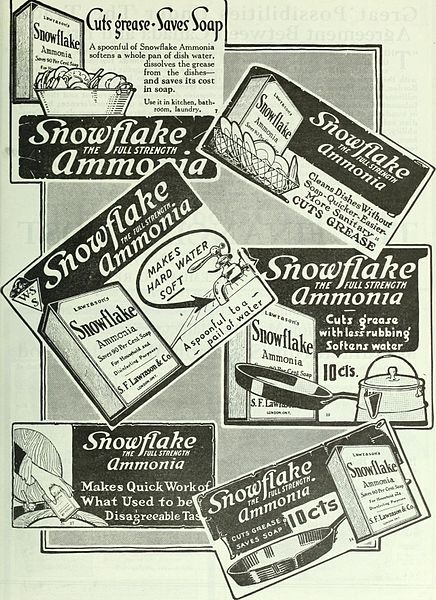A look back at household and medicinal recipes from the late 1800s and early 1900s
A look back at household and medicinal recipes from the late 1800s and early 1900s
Homemade household cleaners and health remedies look very different today from how they did one hundred years ago. Take a trip back in time to see how people attempted to keep their homes and themselves clean and healthy.
By Liz Dommasch, County Archivist
Hello, 2021! We made it through 2020, and can hopefully look forward to some normalcy this year. As we wait for the COVID vaccine to be readily available, it’s more important than ever to ensure that we are keeping safe and healthy by ensuring that we keep socially distancing, continue to wear masks in public and of course always keeping surfaces and ourselves clean. With that said, I thought it might be fun to look back at a few household disinfectant and cleaning recipes, as well as homemade medicines, from the later 1800s and early 1900s to see how people over 100 years ago not only kept their homes clean and tidy, but how they attempted keep themselves healthy when faced with an ailment or disease.
The Home:
Uses of Ammonia – All housekeepers should keep a bottle of liquid ammonia, as it is the most powerful and useful agent for cleaning silks, stuffs and hats. In fact, it cleans everything it touches. A few drops of ammonia in water will take off grease from dishes, pans, etc. and does not injure the hands as much as the use of soda and strong  chemical soaps. – 1887-1924 Useful Household Hints by Just a Thought Publications, 1992.
chemical soaps. – 1887-1924 Useful Household Hints by Just a Thought Publications, 1992.
Washing Fluid – ½ ounce ammonia, ½ ounce salts of tartar, 1 can Gillettes lye, 4 quarts boiling water (soft), use ¾ cup to a boiler. Use stone jar to mix. Put water on slowly, stand back as far as possible as it effects the eyes. Put in a gallon jar to keep. – L.N. McLean, Woodstock Cook Book, 1917.
An Agreeable Disinfectant – Sprinkle fresh ground coffee on a shovel of hot coals, or burn sugar on hot coals. Vinegar boiled with myrrh sprinkled on the floor and furniture of a sick room is an excellent deodorizer. – 1887- 1924 Useful Household Hints by Just a Thought Publications, 1992.
Care of Towels – One of the most important, yet most frequently neglected details of kitchen work is the care of towels and dish-cloths. A dirty dish-cloth breeds disease, as it is a hotbed for bacteria, and as it comes in contact with the dishes from which food is eaten, it will be readily seen how it may transfer disease germs to those who eat from them; the wiping only changes the evil from the dish-cloth to the towel. Always wash the dish-cloth, after using it, with soapy hot water, then scald, rinse in cold water and hang out in the sun if possible. - Public School Household Science by Adelaide Hoodless & M.U. Watson, Toronto, 1905.
Furniture Polish – Shave yellow beeswax in turpentine to make it a consistency of paste. When it is dissolved apply with a soft flannel to the surface to be polished and rub well. – Woodstock Cook Book, 1917.
The Refrigerator – A small dish of fine charcoal kept in the refrigerator and renewed every week will absorb the odors and keep everything fresh and clean. – Woodstock Cook Book, 1917.
To Remove Stains on Basin and Bathtub – Rub muriatic acid on the stained part and rinse with cold water. A little ammonia may be added to the rinsing water. Note muriatic acid is apt to injure the fittings; therefore, kerosene is better if the stain is not very bad. - Public School Household Science by Adelaide Hoodless & M.U. Watson, Toronto, 1905.
Medicinal Recipes:

***Disclaimer: Please do not try these recipes at home. There are no proven health benefits or cures related to any of these medicinal recipes. This is just a sample of historical recipes, that sometimes resulted in more harm than good. Those that are ill, should always seek advice from a medical professional.
For Headache – Pour a few drops of ether on one half ounce of gum camphor and pulverize; add to this an equal quantity of carbonate ammonia pulverized; add twenty drops of peppermint; mix and put in an open-mouthed bottle and cork. – Mrs. A.M. Gibbs.
For Sore Throat – Cut slices of salt pork or fat bacon; simmer for a few moments in hot vinegar, and apply to throat as hot as possible. When this is taken off, as the throat is relieved, put around bandage of soft flannel. A gargle of equal parts of borax and alum, dissolved in water, is also excellent. To be used frequently.
Fever and Ague – Four ounces galangal root in a quart of gin, steeped in a warm place; take often – Mrs. R.A. Sibley
Cholera Remedy – Mix in a small bottle equal parts of tincture of opium (laudanum), rhubarb, capsicum (red pepper, double strength), camphor, and spirits of nitre, essence of peppermint double strength. Shake will and cork tight. Dose: from five to thirty drops every fifteen minutes. Dose for children, from two to ten drops. – Mrs. Gardner.
To restore from Stroke of Lightning – shower with cold water for two hours; if the patient does not show signs of life; put salt in the water, and continue to shower an hour longer.
All medicinal recipes credited to: The Home Cook Book by the Ladies of Toronto and Chief Cities and Towns in Canada (Toronto, 1881 [first published 1877]: https://archive.org/details/homecookbook00stew/mode/2up
Image Credits: Influenza poster, 1918. Secretary of Board of Health and Chief Medical Officer of Health subject files. Reference Code: RG 62-4-9-450a.1 Archives of Ontario.
Ammonia Advertisement, Canadian Grocer. January – March 1919. https://archive.org/stream/cangrocerjanmar1919toro/cangrocerjanmar1919toro#page/n4/mode/1up
